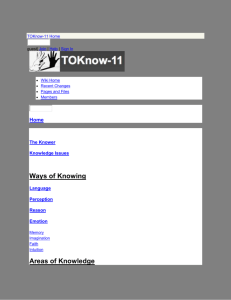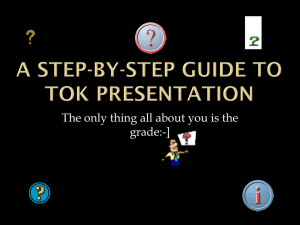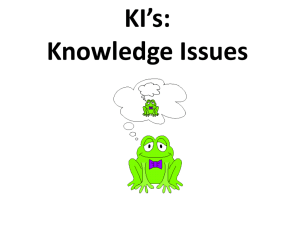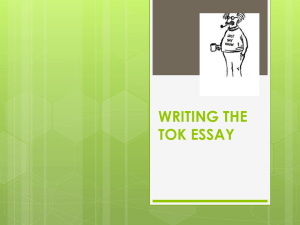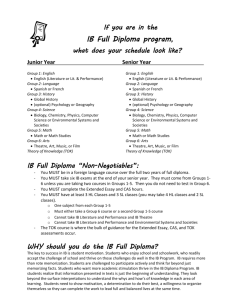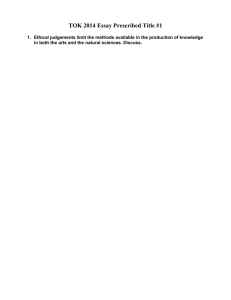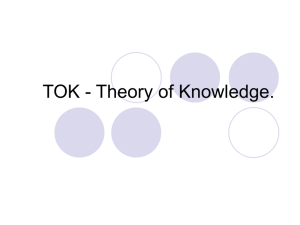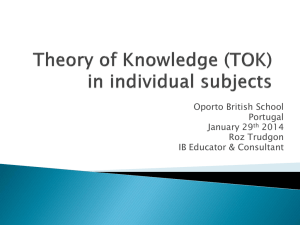COMPUTER SYSTEMS RESEARCH Code Writeup of your program
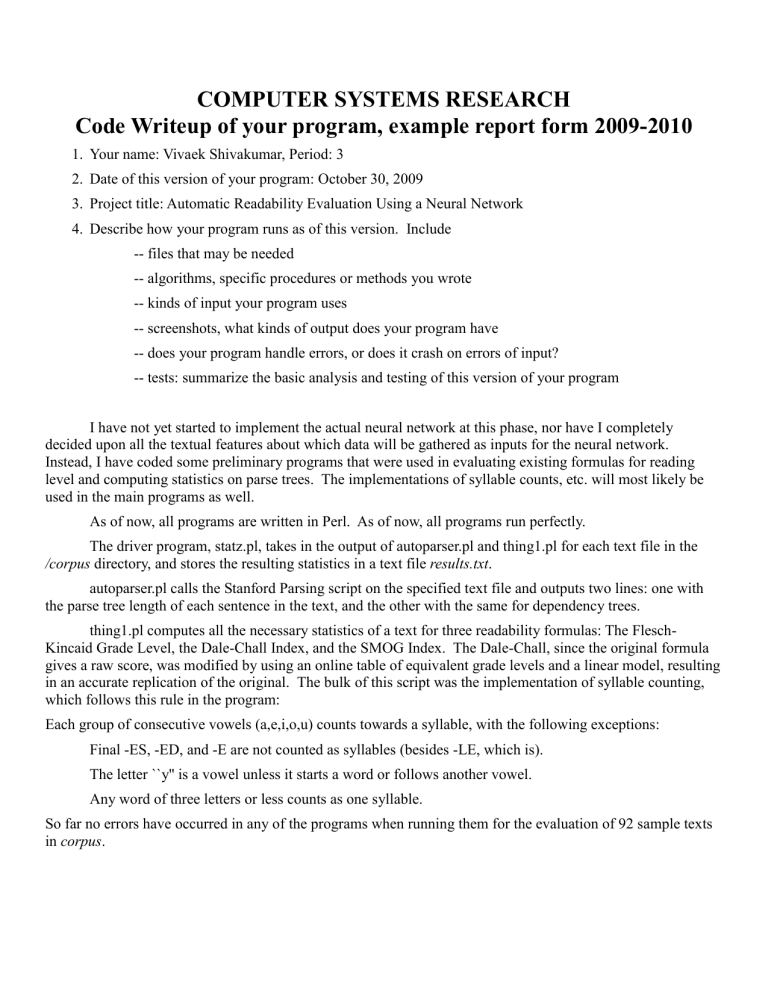
COMPUTER SYSTEMS RESEARCH
Code Writeup of your program, example report form 2009-2010
1.
Your name: Vivaek Shivakumar, Period: 3
2.
Date of this version of your program: October 30, 2009
3.
Project title: Automatic Readability Evaluation Using a Neural Network
4.
Describe how your program runs as of this version. Include
-- files that may be needed
-- algorithms, specific procedures or methods you wrote
-- kinds of input your program uses
-- screenshots, what kinds of output does your program have
-- does your program handle errors, or does it crash on errors of input?
-- tests: summarize the basic analysis and testing of this version of your program
I have not yet started to implement the actual neural network at this phase, nor have I completely decided upon all the textual features about which data will be gathered as inputs for the neural network.
Instead, I have coded some preliminary programs that were used in evaluating existing formulas for reading level and computing statistics on parse trees. The implementations of syllable counts, etc. will most likely be used in the main programs as well.
As of now, all programs are written in Perl. As of now, all programs run perfectly.
The driver program, statz.pl, takes in the output of autoparser.pl and thing1.pl for each text file in the
/corpus directory, and stores the resulting statistics in a text file results.txt
. autoparser.pl calls the Stanford Parsing script on the specified text file and outputs two lines: one with the parse tree length of each sentence in the text, and the other with the same for dependency trees. thing1.pl computes all the necessary statistics of a text for three readability formulas: The Flesch-
Kincaid Grade Level, the Dale-Chall Index, and the SMOG Index. The Dale-Chall, since the original formula gives a raw score, was modified by using an online table of equivalent grade levels and a linear model, resulting in an accurate replication of the original. The bulk of this script was the implementation of syllable counting, which follows this rule in the program:
Each group of consecutive vowels (a,e,i,o,u) counts towards a syllable, with the following exceptions:
Final -ES, -ED, and -E are not counted as syllables (besides -LE, which is).
The letter ``y'' is a vowel unless it starts a word or follows another vowel.
Any word of three letters or less counts as one syllable.
So far no errors have occurred in any of the programs when running them for the evaluation of 92 sample texts in corpus .
Code for thing1.pl: undef %iscommon; for (@commonwords)
{
$_ = substr($_,0,length($_)-1);
$iscommon{lc($_)} = 1;
} foreach $line (@lines)
{ elsif(($tok =~ /(es|ed|er|ly)$/) &&
$iscommon{substr($tok,0,length($tok)-2)})
3)})
#!/usr/bin/perl open(IN,$ARGV[0]);
@lines = <IN>;
$wordct = 0;
$syllablesct = 0;
$sentencect = 0;
$comwords = 0;
$compwords = 0; open(DCL, "dclist.txt");
@commonwords = <DCL>; close(DCL);
@toks = split(/[\s(--)]/,$line); foreach $tk (@toks)
{
$syllablect = 0;
$tok = lc($tk); if(length($tok)>0)
{
$wordct++; if($tok =~ /[\!\?\.;:]/)#sentence ending marks
{
}
}
}
} elsif(($tok =~ /s$/) && $iscommon{substr($tok,0,length($tok)-1)})
{
}
$sentencect++;
#take off non-word characters while($tok =~ /\W$/)
{
$tok = substr($tok,0,length($tok)-1); while($tok =~ /^\W/)
{
$tok = substr($tok,1,length($tok)-1);
#check if part of Dale-Chall 3000 easy words list if($iscommon{$tok})
{
$comwords++;
{
$comwords++;
} elsif(($tok =~ /(ing|est)$/) && $iscommon{substr($tok,0,length($tok)-
{
$comwords++;
$comwords++;
} if($tok =~ /\d/)
{
}
$syllablect = 2*length($tok)-1;
"y"
#if less than four letters, one syllable elsif(length($tok)<4)
{
} else
{
}
$syllablect = 1;
$vowlz = ($tok =~ tr/aeiou//);
$syllablect += $vowlz;
$yct = 0;
$cnt = 1; for($i = 0; $i < length($tok); $i++) #covers the dual nature of
#if y follows a vowel or starts a sentence, it is not a vowel
{
$ch = substr($tok,$i,1); if($ch =~ /y/)
{
}
}
} unless($cnt)
{
}
$yct++; if($ch =~ /[aeiou]/)
{
$cnt = 1; if($ch =~ /[bcdfghjklmnpqrstvwxz]/)
{
$cnt = 0;
}
$syllablect += $yct;
#ignores final -ED, -ES, -E (except -LE) if($tok =~ /(e[ds]$)|([^l]e$)/)
{
}
$syllablect--;
$minus = 0;
$minus++ while $tok =~ /[aeiou][aeiou]/g;
$syllablect -= $minus;
}
$syllablesct += $syllablect; if($syllablect >2)
}
{
}
$compwords++;
}
$gl = 0.39*(($wordct+0.0)/($sentencect+0.0))+11.8*(($syllablesct+0.0)/($wordct+0.0))-
15.59; print "The Flesch-Kincaid Grade Level:" . $gl . "\n";
$dalechall = 0.1579*(1.0-
($comwords+0.0)/($wordct+0.0))*100.0+0.0496*(($wordct+0.0)/($sentencect+0.0))+3.6365;
$dalechallgrade = $dalechall*2.24-7.06; print "Dale-Challe Grade Level:" . $dalechallgrade . "\n";
$smog = 1.043*sqrt(($compwords+0.0)/($sentencect+0.0)*30.0)+3.1291; print "SMOG index:" . $smog . "\n";
Code for autoparser.pl (calls the Stanford Parser):
#!/usr/bin/perl
$treez = `./Parser/stanford-parser-2008-10-26/lexparser.csh $ARGV[0]`;
@treestatements = split(/\n+/,$treez);
$parct = 0;
$depct = 0;
$last = 0;
@parcts = ();
@depcts = (); foreach (@treestatements)
{ if(/^\s*\(/)
{
} else
{
} if($last)
{
} else
{
} push(@parcts,$parct); push(@depcts,$depct);
$parct = 1;
$depct = 0;
$last = 0;
$parct++;
$depct++;
$last = 1;
} push(@parcts,$parct); push(@depcts,$depct); foreach (@parcts)
{ print $_ . " ";
} print "\n"; foreach (@depcts)
{
} print $_ . " "; print "\n";
Code for driver program statz.pl:
#!/usr/bin/perl use List::Util qw(sum);
@fnames = <corpus/*>; open(OUT,">>results.txt"); print OUT "Grade Flesch-Kincaid Dale-Chall SMOG Average-Parse-Tree-Height Average-
Dependency-Tree-Height\n\n"; foreach $fname (@fnames)
{
$parseout = `perl autoparser.pl $fname`;
$indexout = `perl thing1.pl $fname`;
$g = substr($fname,7,2); if($g =~ /[^0-9]$/)
{ chop($g);
}
@temp = split(/\n/,$indexout);
@t1 = split(/:/,$temp[0]);
@t2 = split(/:/,$temp[1]);
@t3 = split(/:/,$temp[2]);
$fk = $t1[1];
$dc = $t2[1];
$smog = $t3[1];
@temp = split(/\n/,$parseout);
@parsizes = split(/\s+/,$temp[0]);
@depsizes = split(/\s+/,$temp[1]);
#the three readability indexes
$apth = sum(@parsizes)/@parsizes; #average parse tree height
$adls = sum(@depsizes)/@depsizes; #average dependency list size
# we now have $fk, $dc, $smog, $apth, $adls each to be compared to the "actual" grade level $g print OUT "$g $fk $dc $smog $apth $adls\n"; print "\n\n";
} close OUT;
HERE IS PART OF THE OUTPUT “results.txt”:
Grade Flesch-Kincaid Dale-Chall SMOG Average-Parse-Tree-Height Average-Dependency-Tree-
Height
10 10.5320949432405 15.110564127967 12.2147228055487 22.1428571428571 16.5714285714286
10 6.90124771524772 8.44947346531987 8.75964420105197 23.9310344827586 17.3103448275862
10 9.07681551569783 10.0967349676782 10.9245791938706 23.3272727272727 17.1090909090909
10 8.71855940590771 12.476357523039 10.997765177922 19.6823529411765 14.3764705882353
10 7.16967640348121 11.1643608699193 9.76439172838352 15.6538461538462 11.2019230769231
10 7.59493699885453 9.06153188239786 9.99496653914372 24.72 17.36
10 4.95491496462422 7.86295434371913 8.46594033181364 16.1481481481481 10.3888888888889
10 4.95315789473684 5.93628804318489 8.05529536450096 20.9710144927536 14.6086956521739
10 3.26643405079318 7.27200593113379 6.80392413372301 14.4186046511628 9.3953488372093
10 7.86156642259415 11.6987684686192 11.080906280651 18.448275862069 13.5172413793103
10 8.57795321637427 9.70450451461988 11.3137561513474 22.1666666666667 16.6666666666667
10 8.38341642651297 11.8812968207493 10.6321784182228 20.4473684210526 16.3684210526316
10 8.27676470588235 10.8912515475113 11.2854564405079 21 15.7021276595745
10 11.6701355316473 11.9024948419729 12.6279144461482 27.5882352941176 21.7647058823529
11 8.00981425061425 11.1503365598034 9.8885125484394 18.2916666666667 14.9583333333333
11 8.405 10.7532123076923 10.3898737985594 16.7692307692308 13.3846153846154
1 1.00833333333333 4.33141733333334 5.98547313738944 10.125 5.25
1 -0.252419354838707 3.08599088172043 5.46131890053228 7.91666666666667 3.83333333333333
2 0.845650584795322 2.78748914619883 4.73424313183722 10.1578947368421 6.15789473684211
5. What do you expect to work on next quarter, in relation to the goal of your project for the year?
This quarter I will focus on planning the neural network and start coding it. But before that, I plan to decide on which text features I want to include in my neural network and I will write programs and find resources to facilitate computing or obtaining the relevant statistics from a given text file. I will add these to my driver program, the output of which will be used for the neural network.
I will also keep looking for more texts for training set or for testing afterwards.
